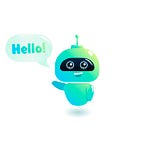AI-based chatbots talk and use machine learning technologies to understand, contextualize, predict and respond to user input. Instead of following a rigid structure, AI relies on natural language processing, natural language understanding, machine learning, deep learning, predictive analysis, and more to provide chatbots with a dynamic and limited user experience. Unlike chatbots, which are rules-based and follow a pre-determined conversation flow, Conversational AI does the opposite.
The biggest difference between chatbots and virtual assistants is the conversation experience, says Smullen. The difference lies in the integration with the back-end systems, which provide the user with information.
The question of what a chatbot is and what conversation art is becomes blurred, considering that there are two key types of chatbots. There are traditional chatbots, smart home assistants and all kinds of customer service software as well as a variety of conversation A.I. Conversational art can be used as a chat bot, messaging app, or voice-based assistant to automate customer communication with your brand.
An AI conversation platform allows you to develop chatbot for mobile app and voice-based assistants to improve your customer service. Businesses can use artificial intelligence (AI) to automate customer-centric touchpoints on social media platforms such as Facebook and Twitter, their websites and apps and with voice assistants such as Google Home. Voice assistants and chatbots are powered by Conversational AI technology.
Chatbots and artificial intelligence are still up for debate as to which of them is the better choice for your business. Chatbots are easier to implement than Conversational AI, to the point where there is a single user-guided process for installing and customizing the system that gives time to focus on the system.
As you probably know, a chatbot is software that uses natural language processing (NLP) to communicate with a user. You can use messaging services, websites, chatbots or voice-based assistants. Chatbots are text interfaces in natural language constructed with rules that promote conserved, AI-driven interactions.
Chatbots for website are designed for the flow of conversation and not smart enough to use previous conversations to establish context information. As a result, interactions with chatbots often seem to be the same, and chatbots do not grow, develop, or learn from conversations.
Conversational AI is strong enough to dominate chatbots, but it takes time to use machine learning to shape the AI’s responses. By processing natural language, chatbots can understand a wide range of inputs and determine the intent of your message.
The user experience of conversation design is an integral part of delivering personalized and insightful customer loyalty. As customers use many devices to access their brands from multiple touchpoints, the growing needs of this sector for the user experience tend to be seamless, and chatbots provide the perfect support.
They can use AI technology to create user-friendly chatbots that generate leads and boost sales. If chatbots fail to live up to expectations, in particular the enterprise market for complex use cases such as banking, insurance and telecommunications, can turn to entertaining AI platforms. Leading banks such as HSBC are already using AI-enabled chatbots on their websites to answer customer questions.
Chatbots have made a quantum leap in user support and contributed to the emergence of the modern service desk. As chatbots evolve, we are witnessing a continuum of progress which makes it impossible to distinguish the difference between human and artificial intelligence switches and customer service functions. Companies are quickly recognizing the ability of AI chatbots to take their services to the next level and improve their business models and customer journeys.
I think it’s instructive to understand the chatbot journey and how it’s evolving from the first generation to a next generation AI that’s unsupervised and context-conscious. It’s not that I don’t understand why a simple chatbot can’t provide me with a real conversation AI.
Chatbots for WhatsApp have been touted as the next stage of the conversation revolution. The chatbot solution with artificial intelligence has never been more popular. The real chatbot craze started 2016 with Facebook’s announcement of a developer-friendly platform to build chatbots for Facebook Messenger.
The conversation with Smullen gave me an interesting perspective on the chatbot and the artificial intelligence market. How can we break down the competition between chatbots, conversation and AI and answer these questions? Conversational AI is a more inclusive technology that falls under the umbrella of the bot than voice bots (voice and text assistants) and chatbots (which have a more limited text annotation ).
In the case of an advanced conversation AI, it provides a superior user experience. Their AI-based chatbots are powered by a range of natural language processing technologies (NLPs).
With demand for better broadband and smart home assistants flooding contact centers, telecommunications companies are using AI to solve technical problems, prevent fraudulent activity, increase worker productivity and allow human agents to focus on back-office operations and training while chatbots take care of customers. But the real secret to the success of chatbots with Conversational AI is how to use them. It is important to understand how modern AI chatbots, also known as AI agents, differ from the first-generation rule-based chatbots.
If scripted robot chatbots cannot predict the intention of the user and engage in meaningful and dynamic dialogue, user interaction will suffer. For this reason, the dynamics behind the development of this new golden age of speech-driven natural language processing (NLP) is to create smart nodes for user engagement.
